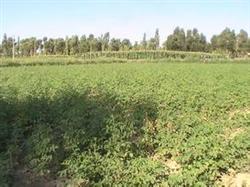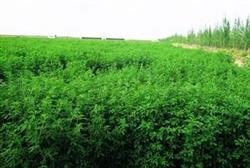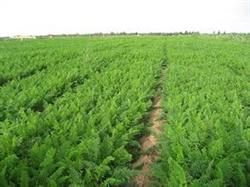Seedling raising and transplanting technique of Glycyrrhiza uralensis

Licorice is an important medicinal material, with the strengthening of national ecological environment protection, the utilization of wild resources has been very limited, licorice seedling transplanting technology has become very important. Licorice is a perennial herb of Leguminosae, which is listed as a key specially controlled medicinal material by the state. Glycyrrhizic acid as a sweetener is 300 times sweeter than sucrose and is one of the best natural sweeteners found so far. The state explicitly orders licorice as a national second-class protected plant, which is not allowed to be picked casually, and the contradiction between the supply and descent of licorice is intensified. Therefore, it is of great significance to study the artificial cultivation and high yield and high quality cultivation techniques of Glycyrrhiza uralensis. 1 morphological characteristics: the plant height of Glycyrrhiza uralensis Fisch is 50ml 120cm. Roots thick, Terete, reddish brown. The rhizome is transverse and its shape and color are similar to those of the root. Stems erect, pinnately compound, alternate, leaflets 7 Mel 17, ovate or elliptic, butterfly-shaped, purplish red, pods curved, falcate, exophytic spiny, seeds round, brownish green, thousand seeds weighing 7 grams. The flowering period is from July to August and the fruiting period is from August to October. (2) Glycyrrhiza uralensis Fisch is mainly distributed in the "three north" areas of China. It is not strict with the soil. Like to grow in weakly alkaline sandy land, grassland, sand, riverbank and desert and semi-desert environment. The black soil introduced to grain producing areas has strong growth potential, showing high yield and high quality. (3) the best way to plant licorice in selected land is to raise seedlings and transplant them, that is, to raise seedlings in the nursery for one year, and then transfer the seedlings to the field in autumn or spring of the following year. Nurture 667 square meters of seedlings, can transplant 5mura 7 mu (667 square meters). Seedling transplanting has a higher grade rate of primary and secondary finished products than direct sowing in the field. With the advantages of less labor and less labor, it is a new cultivation technique with high yield and high efficiency. Licorice is a deep-rooted plant. It should be planted on the land with fertile soil, loose texture, good drainage and rich organic matter. Land preparation should be 40 centimeters deep, while 667 square meters of high-quality agricultural fertilizer 3 cubic meters and 20 kilograms of phosphoric acid should be used as base fertilizer. Then it is ridged 65 cm wide and suppressed to be broadcast. Sowing and raising seedlings can be done in spring, summer and autumn. Spring sowing is from Qingming Festival to Grain Rain, summer sowing is from the Beginning of Summer to Lesser Fullness of Grain, autumn sowing is carried out before the earth is frozen, and seedlings emerge in the next spring. The sowing method is to open a 20 cm wide ditch on the ridge surface with a plough, flatten it after the plough, step on the grid manually, sow the seeds soaked with fungicides evenly on the ridge surface with a little gourd, cover the soil about 2 cm, and then suppress it. Sowing seeds every 667 square meters and 5ml 8kg, the whole seedling can be produced in about 10 days with good soil moisture. In order to prevent grass damage, the herbicide trifluralin can be sprayed on the ridge before sowing. The dosage of 667 square meters should be used according to the reduced dosage of the instructions, and the seeds should be sown every 6 days after spraying. 4 Seedling field management after licorice seedlings are unearthed, they should often go to the field to see if there are dead seedlings. If 100 grams of methyl topiramate powder plus 250 grams of urea and 50 kilograms of water are fully dissolved and sprayed on the leaves of seedlings every 667 square meters, it can effectively prevent the death of seedlings. If there is a lack of seedlings and broken ridges, they should be replanted as soon as possible to ensure the whole seedlings in the field. When licorice grows 6 true leaves, urea is applied once in combination with furrow and furrow, 10 kg per 667 square meters. When there are 10 leaves, the temperature rises and the weeds in the field begin to flourish, so you should shovel frequently, usually 3 times. When the grass shortage is serious, you can spray 150Me and 200g per 667 square meters, which can effectively eliminate Gramineae weeds, and the remaining broad-leaf weeds can be removed manually. There are 100000-120000 seedlings in the nursery field. When licorice has 15 true leaves, green insects may occur. Every 667 square meters, 100ml 200g of methamidophos is sprayed on the water. When aphids occur, 100g omethoate can be sprayed on water. When two kinds of bugs occur at the same time, the two agents can be sprayed together. After the licorice ridge is sealed, we should pay attention to pulling out the big grass in the field as soon as possible, and drain the stagnant water in the field in time in the rainy season to prevent the root rot caused by soaking licorice. According to the investigation, wild licorice has some diseases such as powdery mildew and rust, but this disease has not occurred in artificial cultivation for many years. (5) the yield of field transplanting in autumn was higher than that in the following spring. When transplanting, leave 5 cm stubble and cross stem above the root Reed head, plant as you dig, do not cut the seedlings, and do not allow the overwintering buds and fibrous roots of the root Reed head to be cut off. The root of licorice can be planted horizontally, obliquely or horizontally by ploughing to a depth of 10 cm. The distance between plants is 10 cm, the depth of soil cover is 10 cm, and soil moisture is preserved by pressing. 18000-22000 plants are planted every 667m2, and if possible, it is best to irrigate the roots once before freezing. A series of field management before and after transplanting, such as soil preparation, fertilization, medication and so on, are the same as raising seedlings. Autumn planting takes place after the autumn harvest, and spring planting around the Qingming Festival. 6 harvesting and processing licorice can be harvested in the autumn of the second year after transplanting. In general, 667 square meters of dry goods can be harvested at 800,000kg. In October, the licorice can be harvested by ploughing, removing the soil, and bundled into small handfuls according to different grades of soil roots, lateral roots and forks, and dried for sale. It can also be harvested before sprouting in the next spring. 7 Market and benefit due to the decrease of wild licorice resources year by year, artificial planting has just started, and the price is rising frequently. Licorice is one of the top ten best-selling natural medicinal plants in the American market. It can be said that licorice is a "green bank" that saves money (less investment), land (can make use of sand wasteland and saline-alkali land), labor-saving (extensive management) and high efficiency (in short supply). For example, large-scale cultivation can also process licorice paste, glycyrrhizic acid and other by-products will be more profitable.
- Prev

Cultivation techniques of licorice seedlings
Abstract: licorice root is the material source of a large number of traditional chinese medicine preparations, and widely used in food, beverage, tobacco, daily chemical industry and other fields, the application prospect is broad. However, due to the lack of wild licorice resources, artificial planting efforts should be strengthened. In order to improve licorice seedling planting technology, Urumqi City Grassland Station carried out licorice seedling planting...
- Next

Glycyrrhiza uralensis seedlings transplanting method
The glycyrrhizic acid contained in licorice is 200 ~ 300 times sweeter than sucrose, which is the best natural sweetener found so far. China has exported a large number of licorice and its extract to Europe, the United States and Southeast Asian countries, and it has become a major export medicinal material for earning foreign exchange. Due to the increasing consumption at home and abroad, the resources of wild licorice are becoming more and more exhausted. Therefore, to enter.
Related
- Fuxing push coffee new agricultural production and marketing class: lack of small-scale processing plants
- Jujube rice field leisure farm deep ploughing Yilan for five years to create a space for organic food and play
- Nongyu Farm-A trial of organic papaya for brave women with advanced technology
- Four points for attention in the prevention and control of diseases and insect pests of edible fungi
- How to add nutrient solution to Edible Fungi
- Is there any good way to control edible fungus mites?
- Open Inoculation Technology of Edible Fungi
- Is there any clever way to use fertilizer for edible fungus in winter?
- What agents are used to kill the pathogens of edible fungi in the mushroom shed?
- Rapid drying of Edible Fungi

